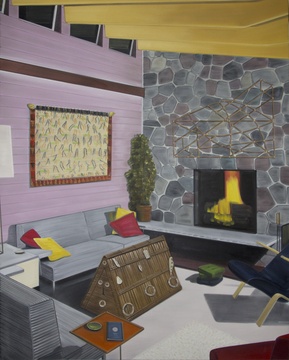Graham Fletcher

Bio.
…spins out new ideas like sparks from a Catherine wheel…[1]
An artist of mixed Samoan and European heritage, Graham Fletcher deftly manipuates the visual and material cultures of both to create works that are politically astute and visually glorious. Delicate flower forms, introduced diseases and affluent domestic interiors have all been carefully captured by Fletcher’s multifarious practice. He has been known to paint the chemical structure of Western medicines as well as alluring and decorative patterns consisting of the ubiquitous frangipani motif.
Pictorial cliches that represent Pacific culture are repeated and subverted- Fletcher sometimes takes his cue from kitsch, commercially-produced, low-art such as plastic lei or lavalava as well as decorative forms creating animal prints, jungley lines and sedimentary textures. Besides meticulous abstract patterning inspired by both souvenirs and indigeous art, Fletcher also depicts ceremonial masks and sacred figurines of pre-missionary gods and goddesses in their reluctant new homes whether they be museum vitrines or bourgeois bookshelves.
The materials called upon for such work are customary and contemporary, reflecting Fletcher’s interest in commingling Western high art and indigenous traditions with the aid of mass-produced, industrial or unexpected components. Not even paint is taken for granted as Fletcher has been known to use oils, acrylic and even rehabilitate discarded enamel paints from a local council disposal facility. Besides being used to create lush, realistic, large-scale canvases, paint is also poured, sculpted, distressed with turpentine, moulded or used to pattern his hardwood sculptures. Fletcher’s supports are as subversive as his treatment of seemingly innocuous motifs, he has painted over precious barkcloth, commercial acetate and made collages of the remainders of former canvases. Additionally Fletcher has engaged with sculpture ranging from plywood forms to carved and painted hardwood, large scale outdoor sculptures and mixed-media installations of totem-like psuedo-ethnographic objects.
Fletcher stretches media to their limits, investigating the paintness of paint by layering and patterning, creating thick, sumptuous, glossy surfaces that belie depth, whether actual, pictorial, conceptual or political. Mining misappropriation, Fletcher collects visually striking subject matter and creates hybrid new forms of art objects. The allure and polish of modernist high art is combined with critical and incisive investigations into contested spaces and representations so that little can be taken for granted.
*
Graham Fletcher (b. 1969) currently lives and works in Dunedin where he is a senior lecturer in painting at the Dunedin School of Fine Art. He completed his Doctorate at the Elam School of Fine Arts, University of Auckland, in 2010. He has exhibited works nationally and internationally in private galleries as well as public art institutions. Recent solo exhibitions include: Lounge Room Tribalism (City Gallery, Wellington, 2011 and Mangere Arts Centre, 2012) and Situation Rooms (Te Tuhi Centre for the Arts, 2012) He has also exhibited within curated exhibitions including the 7th Asia Pacific Triennial (GOMA / Queensland Art Gallery, Brisbane, Australia 2012 - 2013), Home AKL (Auckland Art Gallery, 2012), Oceania (City Gallery Wellington and Te Papa Museum of New Zeal;and, 2011), New Romantics (Calder & Lawson Gallery, University of Waikato, 2011), Spring Trellis (Projectspace B431, Auckland, 2010) and Contemporary Exhibition (10th Festival of Pacific Arts, American Samoa, 2008). Fletcher has received much recognition for his work including the Wallace Arts Trust Development Award in 2010 which included a three month residency at the Vermont Studio Centre in the USA. His work is held in collections throughout New Zealand including Te Papa Museum of New Zealand, Auckland Art Gallery, University of Auckland, Wallace Arts Trust, The Hocken Collection (University of Otago) and internationally the Queensland Art Gallery and the National Gallery of Victoria.
For additional information and a complete CV please contact the gallery.
[1]Warwick Brown, Seen This Century: 100 Contemporary New Zealand Artists. A Collector’s Guide (Random House New Zealand: Auckland, 2009), p. 132.
